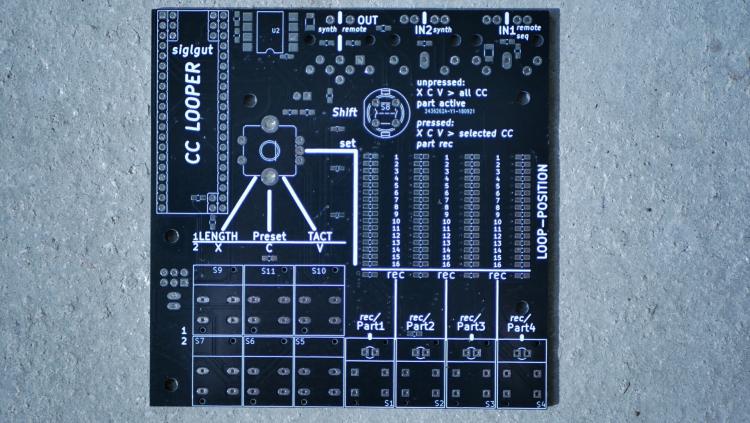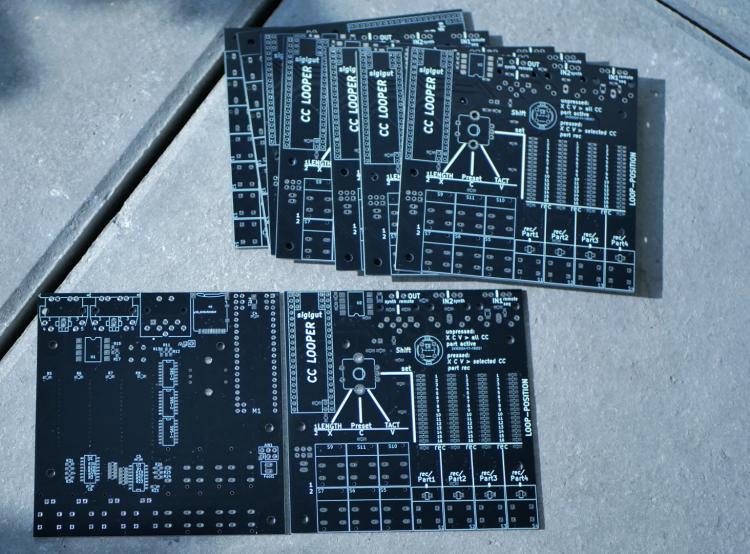-
Posts
1,285 -
Joined
-
Last visited
-
Days Won
72
Content Type
Profiles
Forums
Blogs
Gallery
Posts posted by Phatline
-
-
i set:
#define RESOLUTION 10 // in uS #define TIMER_NUM 1 // TIM3 #define TIMER_PRIO MIOS32_IRQ_PRIO_HIGHwhich give me good timing
thx.
-
i need a count from 0-1ms (to modulate the triggerlength for a TR606 - in order to get some velocity-like reaction from the machine)
count is not the problem, more the execution of the function
also to make a RTOS-Task for it - i know very well and use it a lot.... but since now i dont needet anything under 1ms Rate...
when change from (taken from tutorial 006_rtos_tasks)
vTaskDelayUntil(&xLastExecutionTime, 1 / portTICK_RATE_MS);to
vTaskDelayUntil(&xLastExecutionTime, 1 / 10);has it effect or is it "fixed with min 1ms" ?
are there MIOS functions i can use instead which have a better call-rate?
thx 4 info
-
ok i thougt maybe there is something with the "browse-button" programming and Linux Mint Mate19? in context with PATH-grammatic (/)
so i readout the Path of the hex file with:
t@t:~/Downloads$ readlink -f project.hex /home/t/Downloads/project.hexi then paste the result directly into the Browser-Field of the MIOS-Stock-Built and Mios_Studio i built on this machine (today-after installing all the librarys)
and it F***ing Works!!!
the browser Button, is not in function with Linux Mint Mate 19!
Version Linux Mint 19 Tara 64-bit Kernel Linux 4.15.0-38-generic x86_64 Version Linux Mint 19 Tara 64-bit -
i then built a Mios_Studio on this Linux Mint Mate19 Machine,
but the build give me the same error when loading a hex file:
t@t:~/midibox/mios32/trunk/tools/mios_studio/Builds/Linux$ mios_mate19-2 JUCE v2.0.38 JUCE Assertion failure in juce_File.cpp:149 [1]+ Angehalten mios_mate19-2 t@t:~/midibox/mios32/trunk/tools/mios_studio/Builds/Linux$aha.... i then searched again for "juce_File.cpp" and i found it under: /home/t/midibox/mios32/trunk/tools/juce/modules/juce_core/files
which now exist because i had to unpack the juce files in order to make a BUILT
so line 149 says: jasserfalse - which i think is a break command in this ELSE if... which has something to do with Absulute Pathes and "/" (((dont know what that mean)))
-by the way i searched the .hex-file with the "browse-button" since a drag and drop of hex never worked on Linux anyway (in this case it of course also not worked!)
jassertfalse;else if (! path.startsWithChar (separator)) { #if JUCE_DEBUG || JUCE_LOG_ASSERTIONS if (! (path.startsWith ("./") || path.startsWith ("../"))) { /* When you supply a raw string to the File object constructor, it must be an absolute path. If you're trying to parse a string that may be either a relative path or an absolute path, you MUST provide a context against which the partial path can be evaluated - you can do this by simply using File::getChildFile() instead of the File constructor. E.g. saying "File::getCurrentWorkingDirectory().getChildFile (myUnknownPath)" would return an absolute path if that's what was supplied, or would evaluate a partial path relative to the CWD. */ jassertfalse; #if JUCE_LOG_ASSERTIONS Logger::writeToLog ("Illegal absolute path: " + path); #endif } #endifwhen clicking in the mios-studio browser-adress-bar i get this for example:
/home/t/Gtk-Message: 17:35:54.994: GtkDialog mapped without a transient parent. This is discouraged. /home/t/Schreibtisch/project.hexthe rapid hole getting deeper, and i even dont know "i am in the right hole?"
-
i then tryed to install:
sudo dpkg --add-architecture i386 sudo apt-get update sudo apt-get install multiarch-support sudo apt-get install gcc-multilibwhat changed nothing (stock offically linux built, and my own built - no change off error picture
then i installed 430mb of libarys done with:
apt-get install ia32-libs-multiarchwhich changed nothing...
-
i also tried a on my own compiled version of mios studio - and it fries when try to open a hex file
t@t:~$ mios_msi JUCE v2.0.38 JUCE Assertion failure in juce_File.cpp:149 [1]+ Angehalten mios_msi t@t:~$since i dont found juce_file.cpp in the mios_studio binaries... i only found juce_file.cpp in for example: /home/t/midibox/mios32/trunk/apps/synthesizers/midibox_sid_v3/juce/JuceLibraryCode/modules/juce_core/files
but there is no Line 149 (it is but it is a comment only...)
have no idea, whats happening, maybe there are more i386-librarys that are what needet - but to bad they make no error - so i cant find out which one left, or is there a other problem
-
running but not workgin: when trying to open bootloader.hex (for my lpc17) it says:
Reading project.hex
ERROR: File doesn't exist!(but it exist!:/home/t/Downloads/mios32_bootloader_v1_018/MBHP_CORE_LPC1769/project.hex)
the linux terminal give no error messages --- the error only comes from Mios Studio 2.4.6 itself
puuuh... bad
-
i have a 64bit Linux Mint Mate 19
mios_studio is not running:
meen when i double click, nothing happens,
when i open it with Command-Line i get error messages like: "Error while loading shared libraries: libfreetype.so.6" and others... this things are installed on my system, when i then manually install the i386 library of it - i get it running.
for example:
sudo apt-get install libx11-6:i386 sudo apt install libxext6:i386 sudo apt install libfreetype6:i386 sudo apt-get install libasound2-plugins:i386after that mios_studio is running.
-
thanks for that!

-
i.am open for tips of course. i would order dez. earlyest since have to earn money for it such things before.,..
-
in fact it is 0.1mm less deep that the one used in midiphy seq boomhttps://www.mouser.at/ProductDetail/Kycon/KCDX-5S-S2?qs=Hyo%2fOIDW0pNotQHJom5wpw==
the plastic can get easy cut away with a sidecutter when needet (i had such plug from reichelt and had to cut it away for midiio-pcb )
-
Producer: Shenzen City Xiangyunfeiwu Technology CO. LTD: https://xyfwcn.en.alibaba.com/

- i just dont want to spend 2,5€ for a Din Socket on Mouser > they are crazy...
-
i could get 500 Midi Socket for 127€ excl Import taxe from china --- which give about 0,25-0,5€ for a Socket ---
anyone interested to take 100? (i am in austria)
- dont think i want to hold more then 100 here in my workplace - so 400 would be aviable.
best mike.
-
may it helps anyone - i have made a boom for aviable LCSC.com parts > there are quite much that have to order from mouser anyhow (i have qoted them - but i am not very confident they will be cheap)
(untested)
-
 1
1
-
-
(deletet content) forget it --- my fail (this excel list and numbers .... getting confuzed)

-
cool thanks
-
652-3306F-1-103 (for displays?) can i substitue the 10K trimmers @ corekit with 20K ones? >
-
to 6N136, by searching the midibox forum there are some posts that they used th 6n136 with no problems... i will try them...
to not blow up the SEQV4+ tread:
? see i right that you add this lines @ the end of boom:
CORE:Quote571-1487595-1|1
467-SDSDAA-008G|1
517-89110-0101|6
517-89116-0101|2
523-135-2801-010FT|4
523-135-2801-016FT|4UI:
Quote517-89116-0101|5
517-89124-0101|1
517-89108-0101|1
517-89110-0101|8
523-135-2801-010FT|2
523-135-2801-016FT|2
523-191-2801-124|2all other is unchanged? > means you just add this lines to the end of the Boom List?
-
in UI-Essentual-Kit - the last element of the boom is used the maker number: (makes not a different, but it confuzed me... came to a part which not exist, but as i can see evertything is in stock! sorry.)
4816P-T02-103LF|1 (thats maker nr.)
652-4816P-T2LF-10K|1 (thats mouser nr.)
782-6N138 CORE-essentual-Kit 1800 in stock - but stopped production - can i take 6n136 instead? or others (will not that go away that fast,but since on lcsc they have for example 136 but not 138...for example)
-
i have finished going thru the BOOM (making a excel for what i order from lcsc and what from mouser)... there are a couple mouser not in stock with weeks of lead time... (just a note, doesnt matter for me - same for lcsc ... until all is aviable, there will be some other not in stock, while other get in stock again...i understand)
quest: the "517-929836-01-36-RK" (2x72pin header) is it really needet@once? > or is it to cut down to get smaller pin headers? --- i ask because its 3,4€ on a other side i could get e.g. 3x40 for 0,3€ each...
-
so everything is aviable now?
-
I am sourceing cheap alternatives to mouser, for my projects, and for you dipcorei want to try https://lcsc.com for some of the parts. (some parts i already put in your dipcore wiki boom)
some questions:
RESISTOR:
do they need to be 1/4W or are there some where 1/10W is enough?
CRYSTAL:
i dont know what Quarz you take... but when look at the footprint then it looks like it can only be "Reflowed" ? since the solder points are under the crystal? most of the Crystals i found have it under the Body...
for example: 8MHZ 12pf
how we solder them?
C12-C13:20pf - had to be changed when using a other crystal.... so for the example above i would replace it with 12pf (or is there more i have to think of?)
-
4Midichannels @ each 512Steps X 32th X 128 CCs
of course only a few of the 128CC should be used @ once - 4x128xCCs @ 32th is Midi Data MESS and µC Death

maybe only 256Steps, will depend on RAM.... RealWorld will tell
each TRACK has a shared Track length for all its 128 CCs,
The Whole Track can be copied, or a single CC.
There is no EDIT, you can erase a CC or Track and make it new/override
CC-Looper need a Synth with LEDRINGs -otherwise you have no Feedback and Overview.
--- for Synths without LEDRINGS i take MSQ-CC-LRE http://wiki.midibox.org/doku.php?id=msq-cc-lre - it has 8x32CCs and can automate them, and Save and Dump/Recall-them - CC-Maping is Hardcode.
-





Stephan Bodzin live @ Piz Gloria for Cercle
in Songs & Sounds
Posted
posing controller . haha a good one
. haha a good one